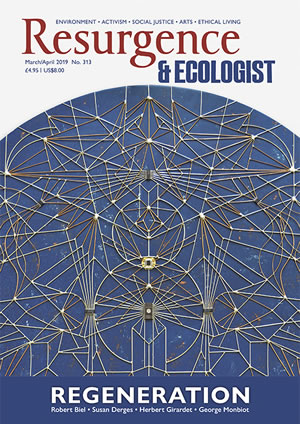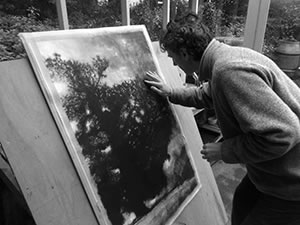It’s a bright morning, closer to the crispness of autumn than the haze of summer. I’m in a field on the Dorset/Wiltshire border and I’ve got my arms wrapped around a tree. The chances of me being the first person to hug this ancient oak are pretty remote. It’s clearly been here hundreds of years and I imagine many people have felt drawn to embrace its gnarled, fissured trunk. There’s just something about oaks that resonates with us.
I’m not your common or garden tree-hugger, though. I’m actually measuring its girth. It is a solid seven metres round. The basic calculation is that one metre equals 100 years, which makes this leafy giant a mind-boggling 700 years old. Its size, its sturdiness, the sense of centuries passing – no wonder the oak has come to symbolise wisdom to us. In my latest work, I celebrate that history and that special place in our hearts, to highlight the plight of the UK’s ancient oak.
My forthcoming exhibition Tree.Life centres on the fact that precious ancient woodland now covers just 2% of the UK and even this tiny acreage is under threat from industrial farming practices, development, HS2 and the mysterious acute oak decline. It’s part of a sad statistic that only 10% of England is covered by woodland, compared with a European average of 37%. For these amazing trees to have survived all that time and to be lost on our watch makes me deeply sad.
As I set up my easel to paint my 700-year-old muse, I pause to consider exactly what its soaring trunk and tangle of branches have witnessed. It started life around the same time as Robert the Bruce was fighting the Battle of Bannockburn in 1314. It was 200 years old when Henry VIII married his first wife, Catherine of Aragon. The Gunpowder Plot imploded when the tree had marked this spot for 300 years. Its half-millennial anniversary would have been just before the first railway service steamed into action – and it’s been producing those pesky leaves that disrupt the line ever since.
I will write these historical events into the background of my finished painting. By documenting its incredible longevity, outliving 17 generations of humans, I create context that I hope will cement admiration of the oak further. But it is not just remarkable in its own right: it is also its very own Noah’s Ark. More than 2,200 species, from bats to beetles, and mammals to lichens, are dependent in some way on the oak. If we lose the trees, the repercussions for other wildlife are equally disturbing.
I also write the names of some of these 2,200 into my paintings. They become almost subliminal messages as I layer ink and watercolour onto the surface. Finally, in an effort to produce the darkest bible black, I also press charcoal into the texture. I’m after an effect that has both light and shade, reflecting the joy and sorrow I experience as I try to raise awareness of the precarious situation of our woodlands.
Around my north Dorset home, for example, I can find plenty of majestic oak trees standing proud from the hedges that divide the fields, but most are only between 150 and 200 years old. Very few are older, even fewer younger. Their great-grandparents may have been harvested and used in buildings. Some may even have been press-ganged into the navy: 6,000 oaks were felled just in the construction of HMS Victory, Nelson’s flagship. Sadly, and more likely, the trees were collateral damage when hedgerows were grubbed out from farmland at a rate of 10,000 miles per year. Until 1997, you did not need permission to cut down these wildlife corridors.
Sadder still, I find very few saplings on my painting forays. Hardly any have been planted in the past 100 years. Our obsessions for cheapness and neatness don’t help. Tractor-mounted flails are used to indiscriminately hack back hedges that were once lovingly laid by hand by a craftsperson who would spot and protect the juvenile oaks within them. Apart from their beauty and their importance as a wildlife habitat, trees play a vital environmental role. Woodland preservation and regeneration are a key part of the Intergovernmental Panel on Climate Change’s latest call to action. Capturing human-made greenhouse gases through tree planting is a no-brainer. We in the UK can hardly complain about worldwide deforestation when we do little to save our ancient woodlands.
I hope my exhibition will help highlight this incredibly important issue. In the meantime, I rescue and protect saplings I find around my home, and I am giving everyone who buys a painting at Tree.Life a UK-grown oak sapling to plant. A small step, admittedly, but, as they say, from little acorns…







